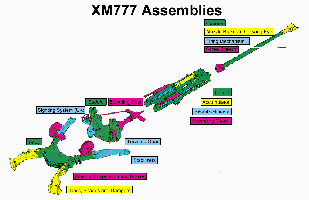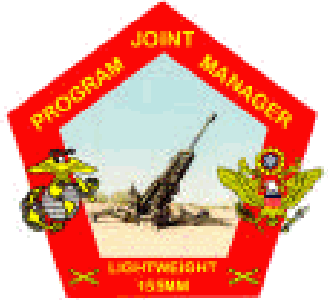 The Lightweight 155 (LW 155), formerly known as
the Advanced Towed Cannon System (ATCAS), LW 155 will replace all US Marine Corps
(USMC) cannon systems and be used as a direct support weapon.
The US Army (Army) will use the system as a general support
weapon in the light forces and as a direct support weapon for the
Light Cavalry Regiment replacing all of the M198 155mm towed
howitzers.
The Lightweight 155 (LW 155), formerly known as
the Advanced Towed Cannon System (ATCAS), LW 155 will replace all US Marine Corps
(USMC) cannon systems and be used as a direct support weapon.
The US Army (Army) will use the system as a general support
weapon in the light forces and as a direct support weapon for the
Light Cavalry Regiment replacing all of the M198 155mm towed
howitzers.
The Marine Corps has a valid, approved, high priority requirement for an advanced towed lightweight 155mm howitzer that meets increased operational thresholds for mobility, survivability, deployability, and sustainability in an expeditionary environment. The Army shares this fire support requirement in the interest of its light forces. The Marine Corps (ACMC) approved a Joint Operational Requirements Document (JORD) in June 1995, and the Army approved it in September 1995. This system combines both Army and Marine Corps efforts to replace the M198 with the more responsive LW155.
The LW 155 will provide close and deep fire support and interdiction fires. It will be lightweight without sacrificing range, stability, accuracy or durability. The system is designed as a howitzer, prime mover and associated equipment. The system shall be deployable to any region and shall operate in most climatic conditions. The US Marine Corps will use the weapon as a direct support weapon, replacing all existing cannon systems. The US Army will use the LW 155 as a general support weapon in the light forces and as a direct support weapon for the Light Cavalry Regiment, replacing the M198 155mm towed howitzer.GENERAL REQUIREMENTS: Weight: 9000 lbs or less Range: 30-40 km (assisted), 22.5-30 km (unassisted) Range Precision PE: .35% (assisted), .30% (unassisted) of range Deflection Precision PE: 1 mil (low angle), 2 mils (high angle) Accuracy: 200-50 meters CEP, at 25 km w/ 20 km Met separation. Minimum Range: 3.7-2.7 km high angle Maximum Rate of Fire: 5-8 rds/min for NLT 2 minutes Min Elevation: 0 mils or less (300 mils for charge M119A2/M203A1) Maximum Elevation: At least 1275 mils Sustained Rate Of Fire: At least 2 rds/min Emplacement Time: 3-2 minutes w/ 5 crewmen (ready to fire) Displacement Time: 2-1 minute w/ 5 crewmen Out Of Sector: 3200 mils left/right in 3-2 minutes w/ 5 crewmen Chamber Temp: Sensor for misfire proc. and ROF limitations External Lift: CH-53E & CH-47D @ high/hot (4000 ft/95oF); MV-22 & CH-53D @ low/cool (Sea Level/60oF) Strategic Lift: 2 in C-130; LW155 w/ PM C-141B, and larger Heavy Drop: Yes (LVAD) from C-130 and larger Ground Mobility: NTE towing capabilities of PM; equiv. fording Prime Mover: USMC - MTVR, Army - FMTV 5 ton Direct Fire PH: 30-80% @ 1500 meters Moving Target Capability: Required w/ lead/night/poor visibility enhancementThe LW 155 indirect fire maximum range shall be at least 30 (threshold) to 40 (objective) kilometers with rocket-assisted US munitions (i.e., M549A1) and 22.5 (threshold) to 30 (objective) kilometers with unassisted US munitions (i.e., M795, M825A1 or XM898) with the M203A1 propelling charge. The LW 155 high angle indirect fire minimum range firing the M107 projectile and current propelling charges shall not be greater than 3,700 (threshold) to 2,700 (objective) meters. Bias errors cause the offset between the fall-of- shot mean point of impact (MPI) and the target. The goal of artillery is to center the MPI on the target. The LW 155 shall have a bias circular error probable (CEP) not exceeding 200 meters (threshold) to 50 meters (objective) at 25 kilometers. This is based upon a two hour MET with 20 kilometer spatial separation from the MET station to the midpoint of the trajectory, firing the M864 projectile at low angle with the maximum charge, and a target location accuracy of 10 meters. Precision errors cause the fall-of-shot pattern. They are related to the interaction of component tolerances, such as cannon, fire control, projectile, and propellant. The LW 155 range precision probable error for low angle indirect fire shall not be greater than 0.0030 (.3 percent) of range for unassisted projectiles and 0.0035 (.35 percent) of range for assisted projectiles. Deflection probable error shall not exceed one mil at any range in low angle fire and two mils in high angle fire for both assisted and unassisted projectiles. The maximum rate of fire for the LW 155 shall be at least five (threshold) to eight (objective) rounds per minute firing all allowable shell/charge combinations (Copperhead excluded) for not less than two minutes in low angle fire (800 mils or less). The sustained rate of fire shall be at least two rounds per minute firing all allowable shell/charge combinations (Copperhead excluded) in low angle fire (800 mils or less) for as long as ammunition is available. As a minimum, this quantity should equal the gun section’s basic combat load. The LW 155 (a single weapon) shall be emplaced and ready to fire (weapon is laid, at least one reference point has been established, one round of ammunition is ready to be loaded, and communications with the Fire Direction Center (FDC) are established) by no more than five crewmen including the gunner and four other cannoneers in three (threshold) to two (objective) minutes or less, after the prime mover has stopped in position. Once emplaced, the LW155 (howitzer, crew, prime mover, and associated equipment) shall be loaded and prepared to immediately depart the current location, by no more than five crewmen in two (threshold) to one (objective) minute. The LW155 is a joint acquisition program. The Marine Corps Acquisition Objective (AO) is 598 howitzers, with an Initial Operational Capability (IOC) scheduled for 2QFY02, and Full Operational Capability (FOC) during FY06. The Army’s AO is 740 howitzers with an IOC planned for FY06. To ensure that the LW155 meets the needs of both Services, enhanced technologies and design features not available at Marine Corps IOC will be later incorporated through a preplanned product improvement program. The LW155 threshold weight is 9,000 pounds. The objective weight is as light as practical without sacrificing other performance characteristics included in this document, such as range, accuracy, survivability, and reliability/durability. The system weight includes the basic weapon, optical fire control and section equipment needed to fire the weapon. Non-critical section equipment, M93/94, and radios are not included. The LW155 Mean Rounds Between System Abort (MRBSA) shall be no less than 800 rounds (threshold) to 900 rounds (objective), to be demonstrated with an 80% confidence, when employed IAW with the LW155 Design Reference Mission Profile. The Marine Corps Joint Program Manager and PEO-FAS, as the Army Executive Agent, has structured a program to accomplish the Joint Development and Production of the LW155. The Program Manager planned a combined Milestone I/II (MS I/II) decision for January 1996. The program structure included an initial Shoot-off phase to evaluate existing lightweight howitzers. The Shoot-off phase determined the most promising candidate for meeting the technical requirements in order to down select to the Engineering and Manufacturing Development (EMD) phase; and subsequently into the release for production, via the use of ceiling price production options as part of the EMD contract. The program required a $10M FY99 Long Lead production option in order to assure the required Marine Corps IOC date (and to avoid an otherwise much higher production cost caused by an idle production line). EMD testing is underway at Yuma Proving Ground. The first two XM776 cannon tubes have been delivered and have begun pre-fatigue testing, using the Shoot-off prototype LW155 as the test platform. The first full-bore chrome lined tube will be delivered in mid-September 97 to begin cannon wear testing. Firing tables testing begins in early 1998. The first complete EMD prototype LW155 is to be delivered in September 98. The EMD cooperative agreement between US and UK is progressing. A draft Memorandum of Understanding (MOU) is being staffed. Under the MOU, UK is to provide financial and other support to the US LW155 EMD program, in return for having a UK engineer resident in the JPM office, access to test data and EMD tests, and attendance at various meetings. The UK has recently completed its light artillery study, which has identified the UFH as the towed weapon of choice. Pending approval of the study and requirements development, the UK could procure up to 92 LW155s beginning in FY03/04. The US Army has committed to fully fund Research, Development, Tests & Evaluation (RDT&E) for the third generation of the LW155 Pre-planned Product Improvements (P3I) in FY00-03. The P3I consists of several improvements that will provide technical gunnery solution on the weapon, position location, directional control, inertial navigation, digital communication, muzzle velocity variation management, and on-board power supply. The Army has also committed to fund long-lead production requirements in FY03, setting the stage for procurement of 273 howitzers with full P3I beginning in FY04. Formal Army support of this Joint program is welcome news in the Marine Corps, which is fully funding RDT&E of the weapon itself. The USMC is currently in the POM process for procurement of the P3I suite as a field retrofit to their LW155s after FY03. Kara Aerospace, optical fire control sub-contractor to Textron Marine and Land Systems, is in the progress of concept design for the LW155 fire control, in preparation for a 3 September 1997 concept design review. Seiler Instruments has made an unsolicited proposal to Textron to provide a modified M198 type sight for LW155. Various light source possibilities exist for this modified sight, including Tritium, battery powered LED, or an electric sight. Each has trade-offs among weight, size, durability, reliability, logistic support, and maturity. The lighting issue will be a major topic of discussion at the design review at Kara. The LW155 contract currently calls for delivery ofInteractive Electronic Technical Manuals (IETMs) on Compact Disk. This is intended to replace all manuals, with the operators manual and lubrication order to also be provided in printed copy. The IETM has a print capability to provide hard copy of all the data contained in the IETM. The information will be printed in a user friendly form; however, it will not be in the MIL-STD format. Options are being pursued to ensure computer hardware is procured and available to read the IETMs. As an interim measure until readers become available, paper printouts of all IETMs will be provided to the fleet. The position presented from Ft Sill and the Joint Program Management Office stipulates there must be a "user friendly" printed procedure for preventive and corrective maintenance at the first and second echelon levels.

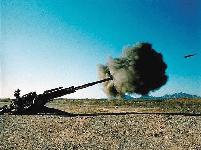


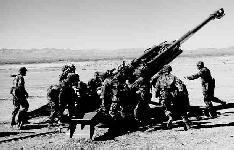
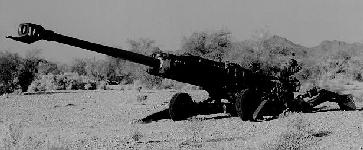


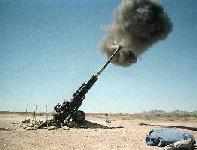

-
The Carriage comprises two subassemblies: the Body & the
Saddle.
- The Body includes two forward stabilizers, and two split trails fitted with self-digging spades and dampers.
- Mounted on either side of the body is a hydragas suspension unit fitted with stub axle and aluminum road wheel. A small hydraulic hand pump is installed at each wheel station to raise and lower the equipment into and out of action.
- A centerpost on the body receives the saddle, and a rack segment, attached to the rear of the body enables the saddle to rotate through 400 mils either side when a pinion on the saddle-mounted traverse gearbox is engaged with this rack.
- The Saddle is fitted with yoke-mounted roll-screw and nut elevating gear actuated by handwheels on either side of the saddle.
- The right-hand handwheel with simple clutch can be used to assist the left via toothed drive belts, pulleys and a cross-shaft. A two-piece extendable drive shaft imparts this manual drive from a handwheel gearbox via an intermediate gearbox mounted on the left-hand end of the roll-screw gearbox trunnion and into the elevating roll screw gearbox and planetary roll screw nut. This nut transmits the drive to the threads of a fixed roll screw terminating in a resilient gearbox fastened to the yoke, thus elevating or depressing the assembly according to handwheel rotation.
- The howitzer’s one-man-operated optical / mechanical sighting system is secured to the left-handed elevating gear. A two-man sighting system is employed on US artillery is provided for the JLW 155 Program.
- A traverse gearbox unit is pivoted on mounting lugs attached to the back of the saddle. It comprises a handwheel-actuated input gearbox, an anti-backdrive unit, a torque limiting clutch and a lower gearbox, all combined.
- The output pinion of the traverse gearbox meshes with the gear rack segment attached to the carriage body, providing 800 mils of traverse.
- A toggle lever operates a mesh adjuster mounted on top of the saddle, either clamping the traverse gearbox into correct mech with the rack or disengaging the mesh for transit.
- The Cradle consists of four large thick-walled tubes with lightweight perforated side frames, and linked together by yokes. The four cradle tubes perform a
useful secondary role as nitrogen gas and hydraulic fluid pressure vessels for the recoil systems and the ‘ equilibrators’ or balancing gear.
- Recoil Cylinders are mounted inboard on either side of the cradle linked to an accumulator site on top of the cradle.
- Equilibrators sited either side above rear of the cradle ease the handwheel effort when elevating or depressing the howitzer.
- The Cannon assembly is an M284 barrel, similar to that used on the American M109 A6 Paladin, fitted with M289 standard screw breech and M49 percussion
firing mechanism.
- Re-orientation has enabled the breech to open in the vertical plane. An automatic Primer Tube Feed Mechanism holding 10 primers is fitted to the breech.
- A muzzle brake adopted from the M198 howitzer reduces blast over-pressure on the detachment and incorporates the towing eye assembly.
- A Mission Manager, digital fire control linking the weapon directly into the Advanced Field Artillery Tactical Data System (AFATDS);
- A Towed Weapon Inertial Navigation System (TWINS), providing inertial navigation during displacements and updated orientation to the Mission Manager during fire missions;
- An on-board Muzzle Velocimeter, providing the Mission Manager with automated updates for each round fired;
- A Direct Fire Sight, providing a first-round-hit capability by combining night vision, laser range finding, and computation of super elevation;
- A Power Supply System, providing reliable power through redundant access to a generator, the vehicle and a back-up battery mounted on the howitzer;
- A Powered Rammer to reduce crew fatigue and support higher rates of fire.
"Bolt-on, bolt-off" Pre-Planned Product Improvements (P3I) for the LW155 will provide this expeditionary weapon with advanced digital technology modules currently found only on heavy self-propelled weapons. These P3I systems fully support the Marine Corps Operational Maneuver From The Sea (OMFTS) and the US Army Task Force XXI objectives. P3I systems will include:
The LW 155 will replace the current M198 towed howitzer in both services with one that is nearly half the weight, yet performs equal to or better than the M198 in every respect. Prospective offers were required to deliver a prototype howitzer to Yuma Proving Ground in April 1996. A seven month competitive shoot-off was then conducted by the LW 155 joint Program Manager, which included technical testing at Yuma Proving Grounds and an operational assessment at 29 Palms and Camp Pendleton, CA.
In what LW 155 Joint Program Manager, Colonel Stephen Ward referred to as a "rigorous competition," the Textron-Vickers team edged out a team led by United Defense Limited Partnership of Minneapolis, Minnesota which teamed with Royal Ordinance of the United Kingdom. Colonel Ward stated that the "comprehensive shoot-off was America's first ever for choosing an artillery system" and expressed his appreciation to both competitors for their "professional conduct and arduous efforts" displayed throughout the competition.
The contract to Textron, worth approximately $40M, covers a three year Engineering, Manufacturing and Development(EMD) program in which eight prototypes will be built. During this phase, design changes will be made to reflect the shoot-off testing as well as improvements which come to light during the extensive testing which will occur during EMD.



